With the increasing reliance on technology in the workplace, selecting and hiring the wrong IT staff can punish your ROI.
By definition, a central goal of your business is to make a profit—income exceeding outgoings. With 60 to 70 percent of business costs consumed by labour, achieving a Return on Investment through hiring and keeping the right staff is the biggest challenge confronting CEOs and CIOs.

Stockbrokers always sign off their recommendations with the disclaimer: Past performance is no guarantee of future returns. But the opposite is true when it comes to identifying and supplying employment solutions in Information Technology.
Define the purpose of your business
Traditional hiring looks at skills, intelligence, academic success and experience. Contemporary IT staff solutions look first to define the purpose of your business—the why of what you do—followed closely by the expected outcomes of the role.
Inherent in both is a Return on Investment, and matching the outcomes of the role as closely as possible to the needs of the candidate.
The old analogy of square pegs in round holes comes to mind.
A critical mistake in some recruitment practices is to exaggerate the list of skills and experience required—an ambit claim—but understate or even ignore the actual task or tasks to be performed against key performance measures.
Great front-line managers - the key to successful business
In their masterful book on management, First, Break all the Rules, authors Marcus Buckingham and Curt Coffman identify the selection and retention of great front-line managers as the key to business success.
Based on Gallup interviews with more than 80,000 employees, they turn traditional views on finding and retaining exceptional staff on their head.
These managers:
• Select prospective staff on talent ahead of experience and skills
• Set out the most desirable and measurable outcomes, not processes
• Work on building and polishing strengths instead of trying to fix weaknesses
• Fit the role to the person rather than pushing the person up the ladder of incompetence (the Peter Principle)
Calculating ROI
Lou Adler is a US recruitment legend and author of the best seller, Hire with your Head. He goes directly to the issue of ROI in recruitment in his series of articles: Quality of Hire: The Missing Link in Calculating ROI.
Expanding on the notion that ‘improvements in candidate quality dwarf potential cost savings’ he assigns actual values to different levels of hire candidates. His findings are startling.
His ranking system cites A-level candidates as making a contribution, or ‘impact multiplier’, to the business assessable at four times their total compensation.
B-level candidates’ impact multiplier is the equivalent of twice their compensation. C-level people are deemed to break even.
From there the curve dips sharply into the red. D-grade employees cause losses equivalent to their compensation; and F-graders cost the company five times their salary.
Define outcomes prior to hiring
By these standards, using the right metrics shows just how crucial defining and measuring outcomes prior to selection and appointment can be.
Are you a CIO or a CEO responsible for IT decisions? Long before you frame an IT recruitment brief for an external agency, or complex job descriptions and wish lists of education, qualifications, skills, and experience, you might do well to pause.
Ask yourself these simple questions: How much money earned, or money and time saved, should this role add to our bottom line? With what management or support? By when and at what cost?
Answers these question and you’ll find talent that can:
• Achieve objectives
• Solve problems
• Deal with people
• Organise teams
• Manage technology
• Make change.
Corporate Information Systems (CIS) is a specialist IT solutions provider of managed resource programs, IT contract and consulting services and executive search and selection services.
